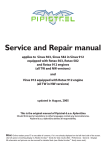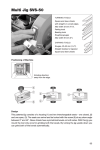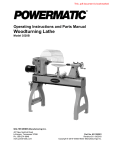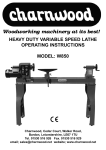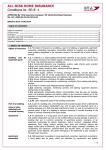Download Nulling Voids: Filling Cracks and Holes in Wood
Transcript
Nulling Voids: Filling Cracks and Holes in Wood by Lynne Yamaguchi (www.lynneyamaguchi.com) Wood cracks. It’s a fact all woodworkers know. Wood checks, it splits, bug larvae eat it (well, not really, but they do chew it up and leave holes), knots fall out, burls form voids—let’s face it: holes happen, and they can ruin a piece or project. But they don’t have to. Cracks and voids can be beautiful in themselves, and filling them can add a different kind of beauty to the finished piece. Adhesives The two adhesives most commonly used to fill cracks and voids in wood are cyanoacrylate (CA) glue and epoxy. Both cure hard but remain sandable, and they shrink little as they dry, so they don’t pull away from the edges of the gaps they are closing. CA glue, also known as Superglue, is available in a range of thicknesses. Thin CA glue will penetrate hairline cracks and permeate fill material; medium CA glue, which has the viscosity of syrup, will fill small cracks and gaps; and thick CA glue, which is about five times thicker than medium, with the consistency of gel or toothpaste, will fill larger gaps. A spray-on accelerant can be used to cure the glue instantly; it works by depriving the glue of oxygen, so anything that does that (water, for example) can also function as an accelerant. This instant curability is one of the advantages of using CA glue. Even without a catalyst, CA glue will dry in just a few minutes. In contrast, epoxy can take from a few hours to a few days to fully cure. What we call epoxy is actually a compound consisting of an epoxy resin and a catalyst, or hardener. These can be bought separately, though they are commonly packaged together. The proportion of resin and hardener to be mixed together can vary from product to product but is commonly 1:1; be sure to check the instructions for the brand you are using. (Mixing in too much hardener can be hazardous, as the curing process generates heat; mixing in too little can delay or prevent curing.) Different combinations of epoxy resins and hardeners have different cure times and thus vary in the length of time they can be worked before they set. The most familiar epoxy products are known as five-minute or thirty-minute epoxies; these nicknames, however, reflect estimates of the time needed for the epoxy to set, or become unworkable—not cure times. Cure time also varies with temperature and humidity. Both epoxy and CA glue are basically clear. Epoxy, though, can be colored by adding pigment; colorants include pigments developed especially for epoxy, oil or acrylic paints (not water-based paints), dry artists’ pigments, tempura powders, and even laser printer toner. CA glue cannot be 1 colored with additives, but Starbond makes both a black and a brown CA glue with medium viscosity. CA glue is sold under various brand names: Hot Stuff, Starbond, USA Gold, Insta-Bond, TMI CA Systems. There are also many brands of epoxy; System Three is one carried by many woodworking supply retailers. Fillers Both CA glue and epoxy can be used in combination with various materials that serve as fillers. Among such fillers are ♦ fine wood shavings or sanding dust; ♦ crushed or pulverized minerals or semiprecious stones (preferably with a Mohs hardness of 6 or less) such as turquoise, azurite, malachite, chrysocolla, biotite (black mica), calcite (alabaster), dolomite, fluorite, and howlite; ♦ metal filings such as brass and copper; ♦ Inlace (synthetic nuggets, granules, powders, and dust, sold dry or in a premixed epoxy); ♦ coffee grounds; and ♦ whatever fibers, flakes, granules, or powders you dare to try. For best results, the filler you use should be roughly equal to the wood in hardness. If one or the other is much harder or softer, sanding will result in an uneven surface (such as happens with spalted wood). In addition, epoxy, which ordinarily has the viscosity of syrup, can be thickened by adding wood flour, phenolic microballoons, or fumed silica, available under the brand name Cab-o-sil and also known as silica thickener. Inlace has its own thickener, Thicken-It, which appears to also be fumed silica. Fiberglass or milled polyester fiber (minifiber) added to epoxy will add strength but will not change its viscosity. Your own lathe is an abundant source of shavings and sanding dust. Often when turning a new wood with a distinctive color, I collect a small container’s worth of shavings and dust for possible future use. I’ve had mixed results using shavings or dust as filler, however. One might expect that filling cracks with fibers from the same wood that has the cracks would help disguise the cracks. The results depend on the wood, however. Mostly, I’ve found that in light-colored woods such as maple and ash, the fill is always darkened by the glue and the result tends to look dirty. In darker woods such as mesquite, the results have been more pleasing. The use of contrasting woods sidesteps this potential pitfall. Craft Supplies, as well as several online sources, sell already-crushed stone by the ounce. Raw nuggets cost less, if you have access to them. Living in Tucson, I go to the local rock shop. Using a capped pipe as a mortar and a steel rod as a pestle, I pound the nuggets until the chips or 2 powder grains are the size I want. Screens of various mesh sizes are useful for separating chips by size, or you can simply use tweezers to select the chips you want to use. As for other fillers, check with a friendly key maker for metal filings or make your own by turning down scrap metal on your lathe. Inlace is readily available from woodworking supply retailers. You can also find promising-looking fillers at craft supply stores. Dry, used coffee grounds have a rich color and a pleasingly shine when used as filler—regular or decaffeinated are said to work equally well. Other possible fillers await you who would imagine and try them. Preparing the Surface The extent to which you must prepare the surface of the wood before filling cracks and voids depends somewhat on the granularity and hardness of any filler you plan to use. If you are using nuggets or granules of stone—even a soft stone such as turquoise—with CA glue, you will save yourself some frustration if you nearly finish the surface before filling the cracks. This is because, once the fill is in, it will chip and pit if you try to cut or shear scrape—or even heavily sand—the surface. “Nearly finishing the surface” means taking your final cut and sanding down to a grit of 150 or so. [Note: The techniques discussed here are specific to turning but can be applied in other forms of woodworking (e.g., furniture making, carving), as well.] If you intend to use a filler when turning an open form (e.g., a bowl), I recommend that, if the crack will pierce the wall thickness you plan, you cut both the exterior and the interior before filling, unless the cracks make the piece structurally unsound. This will allow you better control over the appearance of the fill both inside and outside. If an exterior crack is shallow enough that you are certain it won’t pierce the wall, then fill it whenever you’re most comfortable doing so. (Caveat tornator: Some cracks turn out to be deeper than expected, and some walls end up thinner than planned.) If the appearance of the inside won’t matter, as in some closed (hollow) forms, you can fill even deep exterior cracks before hollowing, with the benefit of increased stability. If you are not using a filler, you can expect to be able to cut and sand the adhesive fill with less chipping and pitting, so the state of the surface when you fill is less critical. There are some factors to consider, however. For example, if your wood is very soft, the difference in hardness between the wood and the fill could cause problems. Also, if the adhesive hasn’t penetrated deeply enough into the crack or recess, you may cut through the fill altogether and have to refill the crack. And if there are bubbles in the adhesive, you may still end up with pitting. Another warning: CA glue—especially thin CA glue—will stain wood. To prevent the CA glue from soaking in and staining the surface, apply paste wax or sanding sealer or the like to the wood around the crack or hole (but don’t get it in the opening). This is especially important if you are filling holes in a nearly finished surface. If the glue does stain the wood, you will need to sand until the stain is gone, or you will need to use a finish that disguises the stain. The longer the 3 glue remains uncured on the wood, the more likely it is to penetrate and stain, so by speeding up the curing, accelerant can help reduce or prevent staining. Moisture interferes with the curing of epoxy, so it won’t work in wet wood. If you cannot wait for the wood to dry, apply acetone to the surface that the epoxy will contact; this may dry it out enough to allow the epoxy to cure. CA glue will cure in wet wood. In either case, however, what happens when the piece dries and the wood moves but the fill doesn’t may not be pretty. Preparing the Cracks and Voids Cracks, voids, and recesses can be natural or intentional, exposed during turning or cut or carved into a piece. Whether natural or not, openings and recesses to be filled must have crisp edges or the fill will look ragged and sloppy. Recesses must also be deep enough to hold the fill you intend to use. Grooves can be cut right on the lathe. Freehand designs can be cut with a Dremel tool, carving tools, or the like. If you want to preserve the natural appearance of cracks, use a dental pick and a razor blade or an X-Acto-type knife to carefully and delicately remove stray fibers and dust and to deepen shallow cracks. To enlarge or otherwise modify cracks, use a Dremel tool. Small round files and small round cutters in a rotary tool are useful for cleaning voids and cleaning frass out of larva (worm) holes. Blow out the whole piece and all crevices thoroughly with compressed air before beginning the filling process. Filling with Adhesive Alone Use CA glue alone for hairline or small cracks. Again, be sure to use paste wax or sanding sealer if you wish to avoid staining. In most woods, clear CA glue will be nearly invisible in hairline cracks. Medium-viscosity CA glue usually dries a little darker than the surrounding wood. Starbond’s black or brown CA glue can be used to highlight small cracks. Apply the glue slowly and let it penetrate the crack thoroughly before using accelerant. Especially when using medium-viscosity glue, wait to allow the glue to flow into the crack. Keep adding glue until gaps no longer appear in the fill; then spray on accelerant or allow the glue to dry. I use epoxy to fill wide or open cracks or voids. (Thick CA glue should also work in these cases, but I have no experience with it and will not attempt to discuss its use here.) If you are adding color, mix the colorant into the resin before adding the prescribed amount of hardener. (Remember to follow the manufacturer’s instructions for the amount of hardener to add.) Use as little colorant as necessary. Adding oil or acrylic paint, in particular, to epoxy can affect its cure time (and its strength). To avoid inhibiting curing altogether, the amount of paint you add should constitute no more than one quarter of the final epoxy mix—and can constitute much less: a dab will do. If you are mixing a color, get the color you want before adding the paint to the 4 resin; this will help you avoid adding too much paint to the mixture or having to mix more epoxy than you need. Using acrylic paint as a colorant will give the epoxy a rubbery texture. Remember that whenever you are working with epoxy, you are working against the clock. As soon as you add hardener, the epoxy begins to set, and depending on its cure time, you may need to work very quickly. For this reason, I strongly recommend working in small batches. You can always mix more as you need it, but once a batch is unworkable, whatever is left is wasted. If you are mixing a color, be sure to mix enough to add to multiple batches. Epoxy is quite liquid and will sag within or flow out of vertical openings, so when using straight epoxy, you can work only on one face at a time and you need to keep the opening horizontal until the compound has set. To hold the epoxy in place, you can dam one side with masking tape, or you can thicken the epoxy to a consistency that will stay in even vertical holes. As noted earlier, epoxy thickeners include wood flour, phenolic microballoons, or Cab-o-sil. (Don’t use Cab-o-sil if you intend to cut the cured fill; because it contains silica, it will dull your tools.) Mix the thickener into the epoxy resin before adding hardener. If you are adding color, mix the colorant, the thickener, and the resin together before adding hardener. Be aware that some thickeners may change the color or opacity of the cured epoxy. Adjust the amount of the thickener you add to achieve the consistency you need. To ensure that the epoxy will adhere in the crack, you can roughen the contact surfaces and “wet” them with plain catalyzed epoxy (i.e., with hardener added but no colorant or filler) before putting in the filler-epoxy mixture. Once you have the consistency you want, apply the epoxy, using a small spatula (I fashion one on a belt sander from scrap wood or a “craft” [popsicle] stick) to push the mixture in if necessary. Try to avoid trapping air under the epoxy, and keep a straight pin handy to puncture any air bubbles that do get trapped, as such bubbles may leave pits or gaps when you later cut or sand the fill. Using a Filler in Combination with the Adhesive If your piece has cracks to be filled on multiple faces (e.g., inside and out, front and back, rim and base), work on one face at a time so that the filler won’t fall out. If you will be using CA glue, protect the surface from staining, then fill the crack with your dry filler. You can achieve different looks by selecting different chip or grain sizes—within the limits of the hole size, of course. Powders will give a more uniform fill; larger granules or chips will preserve more of the appearance of the stone. If you want to be meticulous, separate the chips by size and fill each crack starting with the largest chips and working down to the smallest (or powder). Otherwise, spoon on a mix of chips, granules, and powder appropriate to the size of the crack, and use a dental pick or a thin stick to push the filler as deeply into the crack as you can and tamp it down. Some people recommend filling the crack to above the surface of the wood, but in my experience, you will encounter fewer problems if you leave a slight depression in the filler. Once the filler is tamped in, slowly drip in thin CA glue, letting it soak around the filler. (For a contrasting matrix, use brown or black CA glue, but first make sure that it won’t stain your 5 filler.) Add more glue as it soaks in, until the filler appears saturated. Do not apply accelerant until you are satisfied that the glue has penetrated as much as it is going to, and if you can afford the time, don’t use accelerant at all, as it will make the fill somewhat more brittle than if the glue is allowed to cure on its own. If you have left a depression in the filler, top it off with medium CA glue. This in effect seals the filler. The fill will appear flush with the surface after sanding, but as you sand to the surface, you will be sanding only glue, not filler. This will reduce chip-out and pitting, without detracting from the appearance of the fill. If the crack is deep, work in stages to be sure that the CA glue penetrates the filler. If a crack is especially deep but does not go through the wood, you can fill the bottom with sawdust and glue, then cap it off with the decorative filler. Be forewarned, however, that if something goes wrong and you end up having to take off more wood than you planned, you may remove the decorative fill and expose the sawdust. If you are using epoxy in combination with a filler, thoroughly mix the filler (and colorant, if desired) into the resin before adding hardener. After adding the hardener, apply the mixture to the holes. (Inlace is available dry or premixed; with the premixed, you need only add hardener before filling.) Again—and this is even more true than when using epoxy without a filler—I recommend working in batches. The filler-epoxy mixture can be difficult to work with, because the filler will not always want to flow where the epoxy will. You will almost certainly have to push and scrape to get the mixture into the cracks, and the excess will be messier than with other techniques. And when you sand, expect pitting. Premixed Inlace will give you much smoother results, as the synthetic filler cuts and sands more cleanly than natural stone and other materials. Finishing As noted earlier, CA glue cures quickly, so you can proceed to finishing right away. The cure time for your epoxy should be noted on the label. For premixed Inlace, the manufacturer recommends at least eight hours before turning or finishing. Once the fill has cured, you have several options for removing the excess left around the filled hole. Even if you will be doing your final sanding on the lathe, I recommend removing as much of the excess as possible before going to the lathe, by hand sanding or power sanding. Because often the wood is softer than the fill, you may end up with high and low spots if you start sanding on the lathe too soon. (For this reason, you don’t want to use fillers that are much harder than the wood.) If you nearly finished the surface before filling, then be very careful not to mar the surface when removing the excess. You can use a rougher grit on the fill than you used on the wood surface if you avoid contact with the wood. As you get close to the wood surface, switch to your previous final grit (150 or so) and sand until all excess is gone (whether on the lathe or not). At this point, I stop to inspect the fill, looking for pits or gaps or other flaws. Sometimes you’ll have to go back to the beginning to fill gaps or fix other flaws. Keep in mind the finish you plan to use, as many finishes (e.g., lacquer, varnish, polyurethane) will fill in pits and small gaps. 6 If you’re not using such a finish, you can touch up pits with medium CA glue or clear epoxy; this, of course, will require another round of sanding. Once you’re satisfied with the fill, continue sanding to the finest grit you use, and apply finish as usual. —copyright Lynne Yamaguchi, 2003, 2004, 2010 Additional resources ♦ “Stone Inlay in Woodturnings,” by Stephen Hatcher. Available at http://www.stephen hatcher.com/files/inlay.pdf. Versions also published in American Woodturner, winter 2002 issue, and Woodworker West, March-April 2004 issue. Sources ♦ CPH International, www.starbond.com, 800-900-GLUE (4583): Starbond adhesives ♦ Craft Supplies, www.woodturnerscatalog.com, 800-551-8876: epoxy, CA glue, ground stone, Inlace ♦ Packard Woodworks, www.packardwoodworks.com, 800-683-8876: epoxy, CA glue, Inlace ♦ Woodcraft, www.woodcraft.com, 800-225-1153, various store locations nationwide: epoxy, CA glue, Inlace ♦ your local rock shop 7











